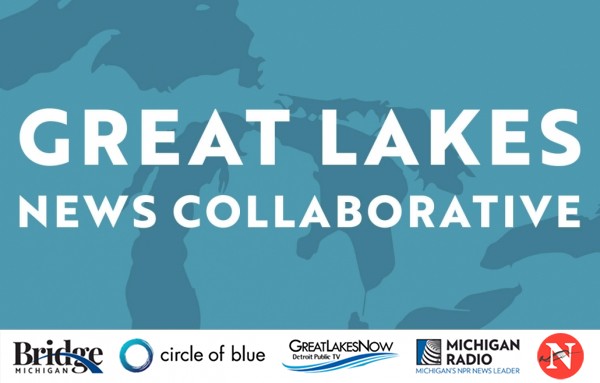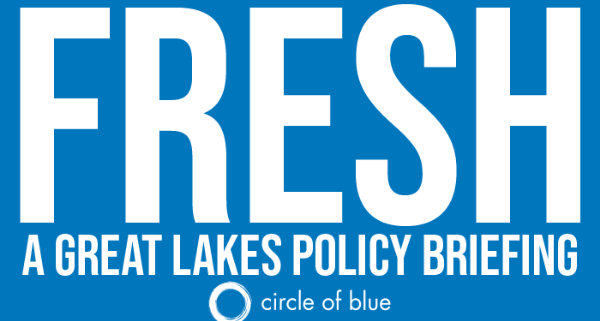Fresh, April 30, 2024: Dredging Begins on Detroit’s Rouge River, One of Great Lakes Region’s Most Toxic Sites
April 30, 2024
Fresh is a biweekly newsletter from Circle of Blue that unpacks the biggest international, state, and local policy news stories facing the Great Lakes region today. Sign up for Fresh: A Great Lakes Policy Briefing, straight to your inbox, every other Tuesday.
— Christian Thorsberg, Interim Fresh Editor
This Week’s Watersheds
- In a landmark decision, Minnesota’s Department of Natural Resources limited farmers’ groundwater diversions in order to protect a trout stream.
- Chicago-area coal-fired power plants on Lake Michigan’s shores face uncertain futures after a new EPA ruling.
- The city of Toledo, Ohio, is suing the U.S. EPA for what it calls “inadequate” plans to prevent phosphorus pollution in Lake Erie.
- The $84 million cleanup of metropolitan Detroit’s Lower Rouge River, one of the Midwest’s most polluted waterways, has begun.
In Thunder Bay, Ontario, a grassroots plastic pollution prevention project is receiving $45,000 from the provincial government.
“These traps not only intercept plastic waste before it reaches our lake, but also serve as a powerful reminder of the need for collective action in safeguarding the health of Lake Superior.” — Ashley Priem, co-executive director of EcoSuperior.
The city of Thunder Bay, located on the shores of Lake Superior, has entered a new agreement with the local nonprofit EcoSuperior to fund the installation of LittaTraps, devices designed to capture plastic pollution at storm drains, CBC News reports.
Some 70,000 pounds of plastic pollution flow into Lake Superior each year via streams, rivers, and other city waterways. The LittaTraps catch pieces of litter at pollution hotspots and will help monitor the type of trash most commonly entering the world’s largest freshwater lake by surface area. With the benefit of $45,000, 16 devices will be placed throughout Thunder Bay.
Fresh from the Great Lakes News Collaborative

- State officials announce $290M MI Clean Water Plan expansion — Michigan Public
- Marbled crayfish raises eyebrows, and concerns — Great Lakes Now
- Michigan fishers are warned about harmful algae ahead of trout season — Bridge Michigan
- Emails show North Bay officials reacting to reporting on plastics factory’s use of PFAS — The Narwhal
Bridge Michigan, Circle of Blue, Great Lakes Now at Detroit Public Television, Michigan Public and The Narwhal work together to report on the most pressing threats to the Great Lakes region’s water. This independent journalism is supported by the Charles Stewart Mott Foundation. Find all the work here.

Rouge River Restoration
By 2030, the U.S. Environmental Protection Agency has pledged to clean all 25 Great Lakes Areas of Concern, sites designated based on their historic and present-day pollution. Among them are the Detroit and Rouge rivers, contaminated by a legacy of coking, coal tar, and chemical plants.
The $84 million clean-up of the Lower Rouge River resumed this month near Zug Island on Detroit’s south side, where sediments are heavily concentrated with toxic heavy metals including polychlorinated biphenyls, known as PCBs. The project began in 2017, when three-fourths of a mile of the river’s old channel were stabilized, before pausing in 2018 as conditions were deemed unsafe. Now, the area will be dredged — removing some 70,000 cubic yards of contaminated sediment, with another 35,000 cubic yards of sediment being capped, the Detroit News reports.
A majority of the project’s expense, roughly $51 million, is being paid by the federal government via the Great Lakes Restoration Initiative and Great Lakes Legacy Act. Nearly all of the remainder, some $28 million, is funded by Honeywell, a North Carolina-based firm that now owns the companies that contributed much of the channel’s pollution in the early 20th century.
In the News
Fossil Fuel-Fired Power Plants: Sweeping new regulations set last week by the U.S. EPA will have big impacts on several Chicago-area industrial power plants, WTTW Chicago reports. Among a series of stricter standards on coal and natural gas emissions, the regulatory body mandated the reduction of “pollutants discharged through wastewater from coal-fired power plants by more than 660 million pounds per year,” according to an EPA news release. Generating stations in Waukegan and Michigan City, both on Lake Michigan’s shores, will need to comply with these standards, cutting emissions by 90 percent by 2039 or shutting down.
Lake Erie Lawsuit: Toledo and Lucas County filed a lawsuit against the U.S. EPA for the federal agency’s “facially inadequate plan” to mitigate phosphorus runoff into Lake Erie, the Toledo Blade reports. It is the latest in a series of lawsuits filed since 2019, which were in response to an algal bloom in the lake that left 500,000 people without tap water for several days.
In Context: Despite $Billions Spent, Tide of Harmful Farm Pollutants Grows Ever Larger
Looking Ahead
Little Rock Creek Trout: Concerned with the stream’s low flows and the health of local trout populations, Minnesota’s Department of Natural Resources has set a limit on how much groundwater growers near the creek can use to irrigate their crops, Minnesota Public Radio reports. Between 1969 and 2022, some 3.7 billion gallons of groundwater across 97 permits have been used to irrigate 12,000 acres of farmland. During times of drought, these diversions can have significant impacts on local channels’ water levels — a shortage that, as of 2023, the state’s DNR has the authority to regulate.
Upcoming Events
May 12 – 16 — International Conference on Aquatic Invasive Species — learn more
May 12 – 16 — 47th Larval Fish Conference (Early Life History Section of the American Fisheries Society) — learn more
May 13 – 16 — Grand Rapids 25th River Rally — learn more
Other News
Western Lake Erie Basin: The watershed, which comprises some 7 million acres, is shared by Michigan, Indiana, and Ohio — yet it has “no state lines,” Outdoor News reports. State agricultural leaders recently met to discuss joint water quality and usage plans.
Superior Watershed Partnership: More than 10 tons of tires, plastic waste, appliances, bicycles, and other pollutants across 200 miles of Lake Superior shoreline were recently cleaned and removed through funding from the NOAA Marine Debris Program, the Newberry News reports.
Christian Thorsberg is an environmental writer from Chicago. He is passionate about climate and cultural phenomena that often appear slow or invisible, and he examines these themes in his journalism, poetry, and fiction.






Leave a Reply
Want to join the discussion?Feel free to contribute!